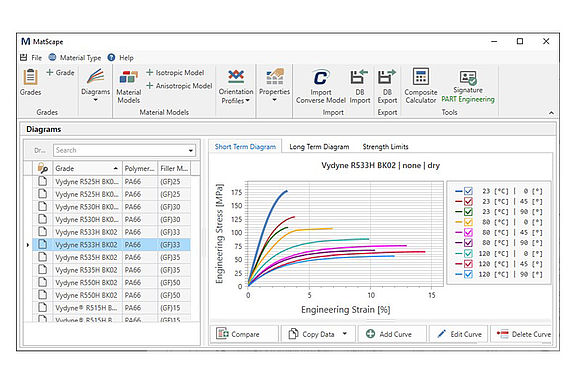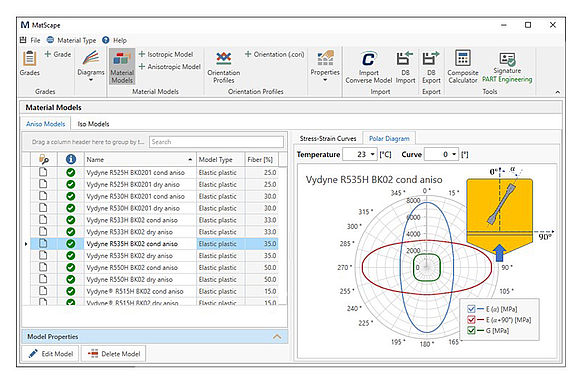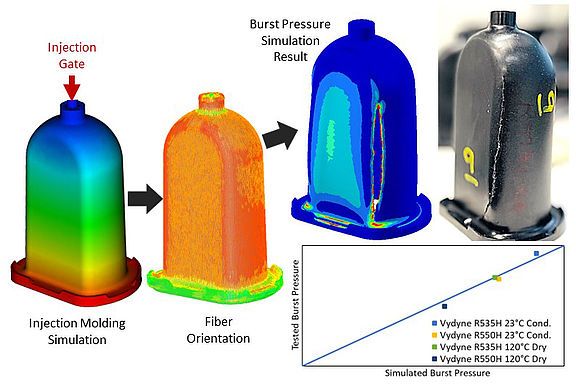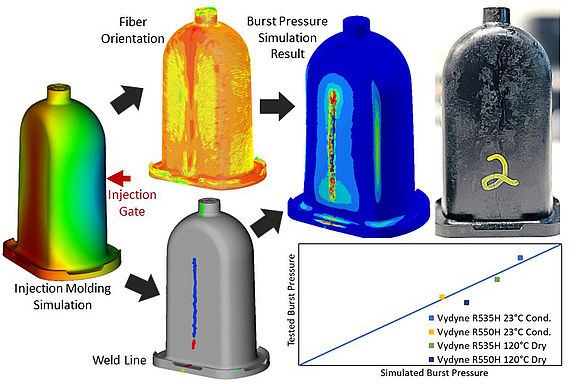Ascend Performance Materials is a leading global producer of specialty materials and chemicals, with a particular focus on nylon. The company was founded in 2009 and is headquartered in Houston, Texas, USA.
Ascend's product portfolio includes a wide range of nylon 6,6 resins and compounds, which are used in a variety of industries, including automotive, electronic, and consumer goods.
In addition to its product offerings, Ascend is committed to sustainability and has established several initiatives to reduce its environmental impact. The company has set a goal of reducing its greenhouse gas emissions intensity by 80% by 2030 and has implemented various programs to increase energy efficiency and reduce waste.
In a cooperation to help customers design and simulate new products Ascend Performance Materials and PART Engineering provide comprehensive material data for holistic simulation.
PART Engineering develops software in the field of structural simulation. This includes the simulation-oriented preparation of material data and the creation of material cards (MatScape), the holistic simulation to capture manufacturing influences on component properties (Converse) as well as the strength assessment of simulation results (S-Life).
Vydyne®
Vydyne is a brand name of nylon 6,6 & nylon 6 resins and compounds produced by Ascend Performance Materials and are types of synthetic polymers that are widely used in various applications due to their excellent mechanical, thermal, and chemical properties.
Ascend Performance Materials produces a range of Vydyne products that are tailored to meet specific performance requirements, such as high heat resistance, impact strength, or low moisture absorption.
Demonstrator Pressure Vessel Correlation
In developing material data for their high-performance materials, Ascend provides not only the tensile data, but also fiber direction-dependent data and even component tests at different temperatures to supply complete material data-sets for their customers’ product designs.
For achieving the best possible performance in a fiber filled part, a realistic component anisotropic simulation is essential in the development phase of a new product. Therefore, Ascend provides material test data for the material database inside PART Engineering’s Software MatScape (Figure 1). This means that every user has access to temperature dependent anisotropic material data in terms of mechanical and thermal properties as well as the CT scan result of the Vydyne material’s orientation.
With this data the realistic material behavior including the fibers can easily be used by PART
Engineering’s software users inside the process-structure-coupling software Converse. Converse assigns the fiber orientation from injection molding simulation software and the calibrated anisotropic material cards to the part’s mechanical solver model by simply using text format solver commands and therefore the mapping can be used in the native solver environment.
Using an Ascend custom-created injection molded pressure vessel part, these material models are tested to also represent the behavior of the part in terms of weld lines. It has two variants with different gate locations, one at the top (Figure 3) and one at the side (Figure 4). With the side gate a critical weld line is placed at one side of the pressure vessel which leads to a failure in that area.
The side-gated results show a completely different behavior, which obviously can´t be identified by leaving out the fiber information and performing the simulation with an estimated isotropic material model. In this case both results would look exactly the same and the best position for the injection gate would not be detected. This seems obvious for this pressure vessel example, but is also valid for more complex structures, especially where there are usually multiple weld lines.
As could be shown, this becomes even more important for higher fiber content, since the weld line effects are even higher.
Pre-calibrated Material Models
Creating realistic material models for simulation based on sparse material data is possible but can be quite cumbersome. With the high-quality material data provided by Ascend Performance Materials it is possible to use the already calibrated material models inside MatScape and Converse as they are (Figure 2). The only prerequisites are correct fiber orientation results from the user’s injection molding simulation and a mechanical solver.
The fiber orientation result as well as the material cards then can be assigned using Converse and also the weld line positions can be considered to predict the reduced material strength in this area.
The failure can be displayed by using an anisotropic failure criterion, e.g. Tsai-Hill, inside the software S-Life Plastics or by adding element deletion to the mechanical simulation to display the fracture.
Summary
With PART software products and Ascend’s material data a holistic simulation is easily implemented in the user’s CAE process chain. By considering the realistic anisotropic behavior of the material, the part failure can be correctly displayed and process-induced influences such as the fiber orientation, weld lines and temperature can be used to help predict the part’s performance before producing costly prototypes.
MatScape’s material database is frequently extended with new releases and even exclusive non-publicly available material data is provided. This helps to attain the best possible design for injection molded plastic parts.
The example shown demonstrates well that the same part, but with different gating positions, leads to completely different behavior. If not considered at an early design stage, this could lead to undesirable behavior and costly design and tooling changes.
Authors:
Sascha Pazour, Simulation and Sales Engineer, PART Engineering GmbH, Bergisch Gladbach, Germany
Ganesh Singh, Global Thermal Application Leader, Ascend Performance Materials, Royal Oak, MI, USA
Vahid Mortazavian, Global Lead CAE, Ascend Performance Materials, Royal Oak, MI, USA



